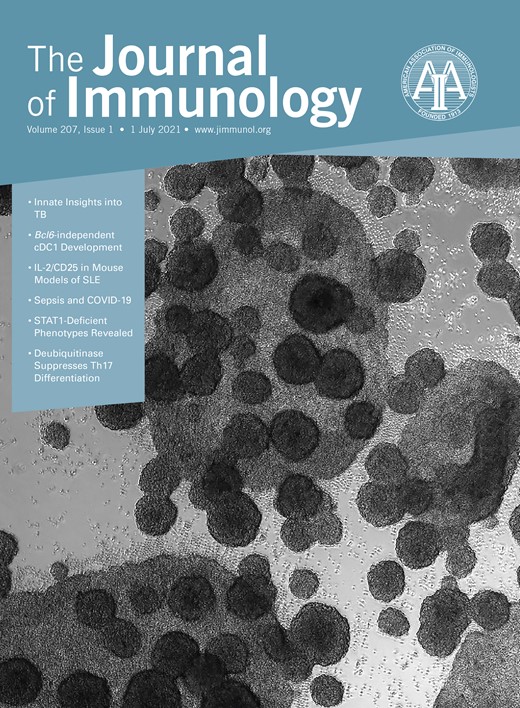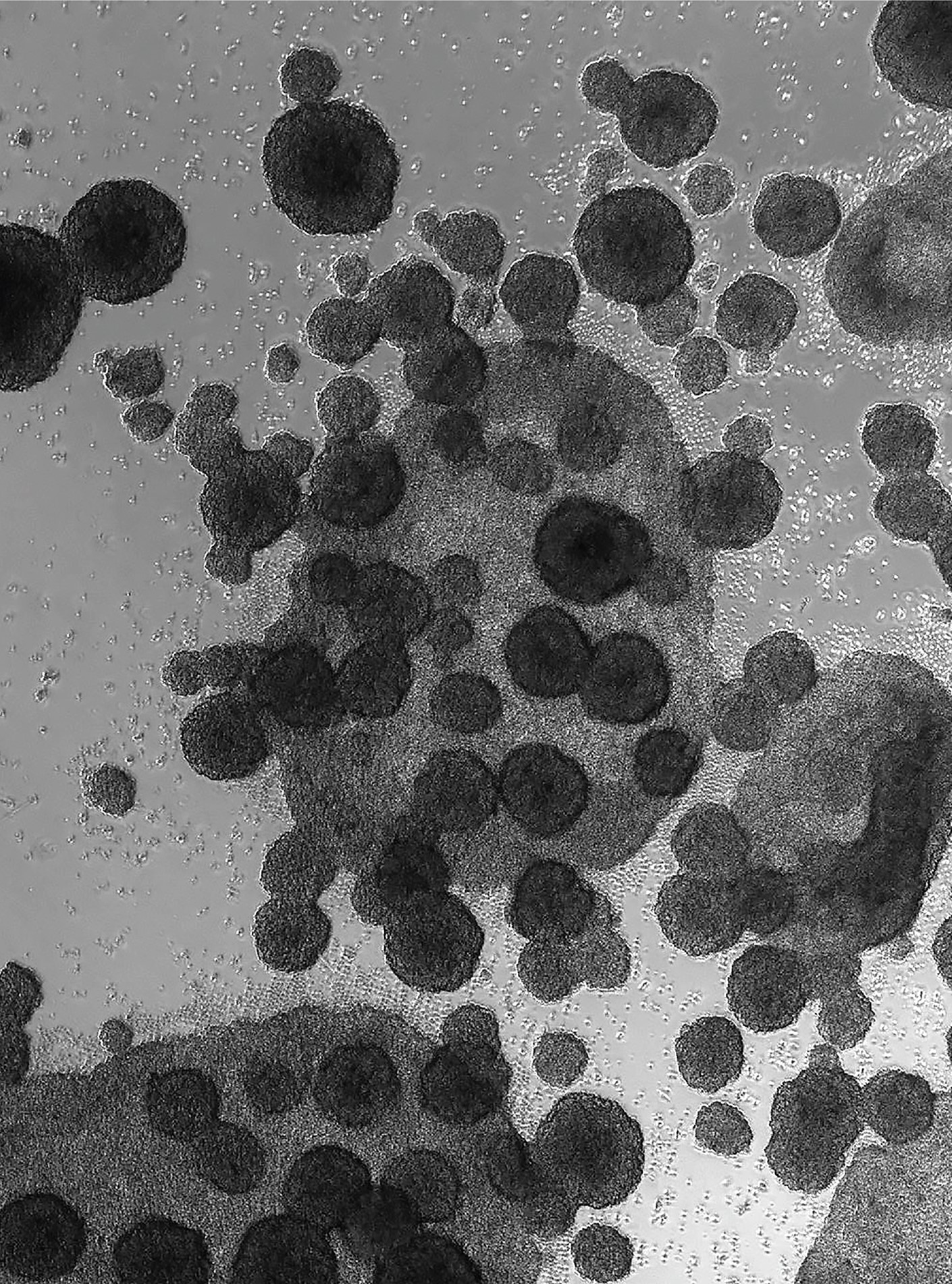
Cover image

On the cover: Proliferating primary human B lymphocytes forming numerous cell clumps when cultured in vitro. Enriched B cells were stimulated with CD40 ligand and IL-4 for three days. The transmitted light image was captured using the EVOS FL imaging system with a 4× phase objective. Possamaï, D., G. Pagé, R. Panes, É. Gagnon, and R. Lapointe. 2021. CD40L-stimulated B lymphocytes are polarized toward APC functions after exposure to IL-4 and IL-21. J. Immunol. 207: 77–89.
Volume 207, Issue 1, July 2021
Top Reads
Top Reads
Pillars of Immunology
T Regulatory Cells Influence Decisions between Concomitant Immunity versus Sterile Cure
Antigen Recognition and Responses
MHC Class II Presentation Is Affected by Polymorphism in the H2-Ob Gene and Additional Loci
Three key H2-Oβ Ig domain residues control H2-O function.
MHCII presentation and antiviral Ab responses are diverse in B6J and B6N mice.
Two non-MHC loci mediate the difference in MHCII presentation in B6J and B6N mice.
Cell-Associated HIV Cross-Presentation by Plasmacytoid Dendritic Cells Is Potentiated by Noncognate CD8+ T Cell Preactivation
HIV-infected H9 cells induce type I IFN production by pDC.
Type I IFN induces IFN-γ but not granzyme B intracellular production in CD8+ T cells.
Type I IFN potentiates IFN-γ secretion only upon cognate cross-presentation by pDC.
Autoimmunity
USP19 Suppresses Th17-Driven Pathogenesis in Autoimmunity
USP19 suppresses the pathogenic potential of Th17 cells.
USP19 removes the K63-linked ubiquitin chain from RORγt lysine 313.
Ubiquitination of RORγt at lysine 313 is essential for recruiting SRC3.
Mouse IL-2/CD25 Fusion Protein Induces Regulatory T Cell Expansion and Immune Suppression in Preclinical Models of Systemic Lupus Erythematosus
mIL-2/CD25 induces Treg expansion and upregulates CD25 expression in mice.
mIL-2/CD25 shows efficacy in inhibiting lupus nephritis in NZB × NZW and MRL/lpr mice.
Meningeal B Cell Clusters Correlate with Submeningeal Pathology in a Natural Model of Multiple Sclerosis
Leptomeningeal B cell accumulation is a prominent feature of GME.
Meningeal B cell infiltrates correlate with cortical demyelination as observed in MS.
GME is a natural model to study compartmentalized neuroinflammation as seen in MS.
Cyclic AMP Response Element Modulator-α Suppresses PD-1 Expression and Promotes Effector CD4+ T Cells in Psoriasis
CD4+ T cells from psoriasis patients exhibit decreased PD-1 expression.
The transcription factor CREMα trans-represses PDCD1 and mediates DNA methylation.
Reduced expression of PD-1 is linked to low IL-2 and high IL-17A production.
Clinical and Human Immunology
Impaired TRIM16-Mediated Lysophagy in Chronic Obstructive Pulmonary Disease Pathogenesis
CSE induces lysosomal damages with LMP.
TRIM16 is responsible for regulating lysophagy during CSE exposure.
Reduction of TRIM16-mediated lysophagy enhances CSE-induced cellular senescence.
CD40L-Stimulated B Lymphocytes Are Polarized toward APC Functions after Exposure to IL-4 and IL-21
Human CD40–B cells are flexible and can be polarized toward distinct functions.
IL-21–CD40–B cells differentiate into Ab-secreting cells.
Combo-CD40–B cells are highly proliferative cells with potent APC functions.
Complex Autoantibody Responses Occur following Moderate to Severe Traumatic Brain Injury
TBI triggers autoantibody production..
Alterations in autoantibody repertoire persist for years postinjury.
Immune Regulation
pH and Proton Sensor GPR65 Determine Susceptibility to Atopic Dermatitis
GPR65-intronic SNP rs8005161 is associated with the risk of atopic dermatitis.
GPR65-deficient mice developed exacerbated atopic dermatitis in an animal model.
pH and GPR65 signaling regulate neutrophil migration and TNF-α production by T cells.
Alveolar Macrophages Inherently Express Programmed Death-1 Ligand 1 for Optimal Protective Immunity and Tolerance
Alveolar macrophages (AMs) inherently express PD-L1.
PD-L1/CD80 cis-interaction on AMs promotes AM phagocytosis.
Trans-interaction of PD-L1 on AMs with PD-1 on CTLs represses CTL activity.
TLR and IKK Complex–Mediated Innate Immune Signaling Inhibits Stress Granule Assembly
Innate immune signaling through TLRs affects stress granule assembly.
TLR signaling promotes disassembly of stress granules that are already formed.
Stress granule inhibition is dependent on the kinase activity of the IKK complex.
Immune System Development
Bcl6-Independent In Vivo Development of Functional Type 1 Classical Dendritic Cells Supporting Tumor Rejection
Bcl6 affects expression of certain cDC markers, such as CD11c and CD8α.
Zbtb46+ DC1s develop in Bcl6cKO mice.
Bcl6cKO DC1s are functional with respect to tumor rejection.
Immunogenetics
Genetic, Immunological, and Clinical Features of 32 Patients with Autosomal Recessive STAT1 Deficiency
AR STAT1 deficiency underly bacterial and viral infections.
Complete STAT1 deficiency is more severe disease than partial STAT1 deficiency.
HSCT is the only curative treatment for AR complete STAT1 deficiency.
Immunotherapy and Vaccines
Timing Effect of Adenosine-Directed Immunomodulation on Mouse Experimental Autoimmune Uveitis
Adenosine and cytokine synergistically augment γδ T cell activation and Th17 responses.
Blockade of the synergism suppress Th17 responses.
Serum cytokine levels predict pro- or anti-inflammatory effect of adenosine.
Infectious Disease and Host Response
SARS-CoV-2 Proteins Induce Endotoxin Tolerance Hallmarks: A Demonstration in Patients with COVID-19
S and N SARS-CoV-2 proteins induce an endotoxin tolerance status in vitro.
S and N proteins are associated with a reduced T cell proliferation in patients with COVID-19.
High levels of S and N proteins increase the proportion of secondary infections.
Pre-existing Simian Immunodeficiency Virus Infection Increases Expression of T Cell Markers Associated with Activation during Early Mycobacterium tuberculosis Coinfection and Impairs TNF Responses in Granulomas
SIV infection reduces CD4/CD8 ratios prior to and during SIV/M. tuberculosis coinfection.
More PD-1/TIGIT-positive CD4+ T cells are in granulomas from coinfected macaques.
CD4+ T cells in granulomas from SIV/M. tuberculosis macaques produce less TNF.
Seneca Valley Virus 3C Protease Induces Pyroptosis by Directly Cleaving Porcine Gasdermin D
SVV 3Cpro directly cleaves pGSDMD to induce pyroptosis.
SVV 3Cpro cleaves GSDMD in pigs, but not in humans or mice.
Distinct Responses of Thitarodes xiaojinensis β-1,3-Glucan Recognition Protein-1 and Immulectin-8 to Ophiocordyceps sinensis and Cordyceps militaris Infection
Recognition of fungi by T. xiaojinensis βGRP1 is vital for proPO activation.
A surface layer prevents O. sinensis from βGRP1 detection.
IML8 binds to βGRP1 in the presence of C. militaris and promotes encapsulation.
The IRE1α Stress Signaling Axis Is a Key Regulator of Neutrophil Antimicrobial Effector Function
Neutrophil IRE1α–CASPASE-2 axis is activated during MRSA infection.
IRE1α–CASPASE-2 signaling promotes neutrophil antimicrobial function.
Neutrophil IRE1α controls Ca2+ flux, histone citrullination, and NET formation.
Novel Role for Macrophage Galactose-Type Lectin-1 to Regulate Innate Immunity against Mycobacterium tuberculosis
Macrophage galactose-type lectin-1 (MGL-1 or CLEC10A) is activated by M. tuberculosis.
MGL-1 plays an important role in controlling mycobacterial proliferation in lung.
Loss of MGL-1 promotes proinflammatory cytokines and lipid accumulation in TB.
TARM-1 Is Critical for Macrophage Activation and Th1 Response in Mycobacterium tuberculosis Infection
TARM-1 was highly expressed on monocytes of active TB patients.
TARM-1 promoted bacterial clearance in macrophage via ROS.
Blocking TARM-1 signal suppressed Th1 polarization and increased TB progression.
Innate Immunity and Inflammation
Zebrafish otud6b Negatively Regulates Antiviral Responses by Suppressing K63-Linked Ubiquitination of irf3 and irf7
Zebrafish otud6b negatively regulates antiviral responses.
Zebrafish otud6b suppresses irf3 and irf7 activation.
Otud6b inhibits K63-linked polyubiquitination of irf3 and irf7.
Gut Microbiota Regulate Gut–Lung Axis Inflammatory Responses by Mediating ILC2 Compartmental Migration
Gut microbiota is involved in innate immune cell regulation.
IL-33 plays an important role in nILC2 migration.
nILC2 and ILC2 migrate to respond to infection and microbial dysbiosis.
Serum- and Glucocorticoid-Inducible Kinase 1 Promotes Alternative Macrophage Polarization and Restrains Inflammation through FoxO1 and STAT3 Signaling
SGK1 promotes alternative, while suppressing inflammatory, macrophage polarization.
SGK1 inversely regulates FoxO1 and STAT3 to control macrophage phenotypes.
SGK1 protects against P. gingivalis–induced periodontal bone loss in a mouse model.
Teleost-Specific MxG, a Traitor in the Mx Family, Negatively Regulates Antiviral Responses by Targeting IPS-1 for Proteasomal Degradation and STING for Lysosomal Degradation
MxG targets and degrades both IPS-1 and STING to impair antiviral immunity.
GTPase and GED domains of MxG contribute to the negative regulatory function.
A variety of viruses achieve the immune evasion through MxG.
Neddylation Alleviates Methicillin-Resistant Staphylococcus aureus Infection by Inducing Macrophage Reactive Oxygen Species Production
Neddylation is activated in mice and macrophages after MRSA infection.
Neddylation facilitates bactericidal ability via increasing macrophage ROS production.
Molecular and Structural Immunology
The Structure of a Peptide-Loaded Shark MHC Class I Molecule Reveals Features of the Binding between β2-Microglobulin and H Chain Conserved in Evolution
We describe a MHC class I structure of a shark, the most primitive species with MHC.
Many features of binding between the heavy chain, β2-m, and peptide are archaic.
β2-m residues Y10, D53, F56, and W60 are critical to form the archaic pMHC-I complex.
TRAF3 in T Cells Restrains Negative Regulators of LAT to Promote TCR/CD28 Signaling
TRAF3 is recruited to the TCR/CD28 complex and interacts with LAT.
TRAF3 enhances TCR/CD28 signaling and restrains the negative LAT regulator Dok1.
TCR-induced kinase activation in TRAF3−/− T cells is enhanced by inhibiting PTP1B.
Tumor Immunology
Retargeting IL-2 Signaling to NKG2D-Expressing Tumor-Infiltrating Leukocytes Improves Adoptive Transfer Immunotherapy
Retargeting IL-2 delivery to CTLs improves immunotherapy.
Regulatory lymphocytes hinder ex vivo expansion of CTLs.
Tumor-infiltrating NK cells and γδ T cells facilitate adoptive transfer immunotherapy.
Novel Immunological Methods
A Rapid Assay for SARS-CoV-2 Neutralizing Antibodies That Is Insensitive to Antiretroviral Drugs
We developed a rapid proximity-based assay for neutralizing antibodies to SARS-CoV-2.
The assay measures binding to the spike that blocks ACE2 recognition.
Unlike pseudovirus assays, the method is insensitive to HIV antiretroviral drugs.


